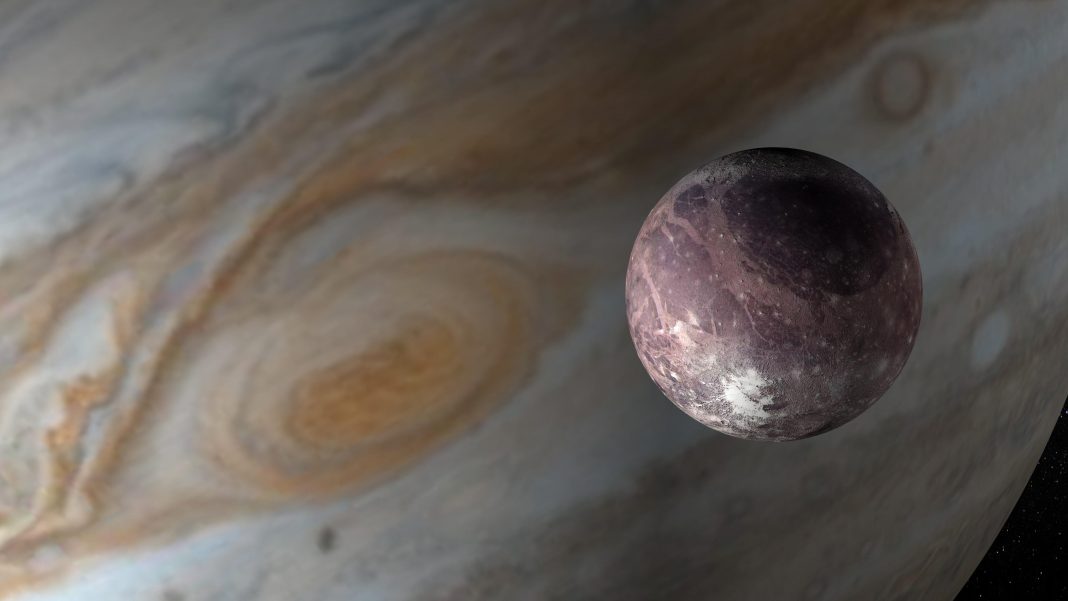Science An Object 90 Miles Wide May Have Struck Jupiter’s Planet-Sized Moon Ganymede Say Scientists Jamie Carter Senior Contributor Opinions expressed by Forbes Contributors are their own. I inspire people to go stargazing, watch the Moon, enjoy the night sky May 24, 2022, 08:00pm EDT | Share to Facebook Share to Twitter Share to Linkedin Jupiter planet and satellite Ganymede in the outer space. 3d render getty The troughs that dominate the surface of the solar system’s largest moon Ganymede may have been caused by a collision with a massive object up to 90 miles/150 kilometers wide.
That’s according to a new paper published on pre-print service arxiv. org by Japanese scientists. If the theory is true then it’s the largest impact structure identified so far in the solar system.
Ganymede is the largest of Jupiter’s estimated 79 moons and bigger than both dwarf planet Pluto and the planet Mercury. Its diameter is 3,273 miles/5,268 kilometers. It’s the only moon we know that has a magnetic field.
It also has an atmosphere and is suspected of having an underground saltwater ocean. Ganymede, The Jupiter’S Moon, A Close-Up Of Ganymede’S Surface Taken On May 20, 2000, By The Galileo . .
. [+] Spacecraft Shows A Region Of Diverse Terrain About 55 Miles (90 Kilometers) Long. (Photo By Encyclopaedia Britannica/UIG Via Getty Images) Universal Images Group via Getty Images Ganymede’s surface is pock-marked, grooved and patterned.
The paper argues that the furrows across its surface are part of a a concentric system of tectonic troughs. “If this multi-ring structure is of impact origin, this is the largest impact structure identified so far in the solar system,” reads the paper. “The estimate of the impactor size is difficult, but an 150km-radius impactor is consistent with the observed properties of furrows.
” The scientists used images taken in 1979 by NASA’s Voyager 1 and 2 probes as well as in images taken by NASA’s Galileo spacecraft, which orbited Jupiter between 2001 and 2003. NASA’s Juno spacecraft photographed Ganymede during a close flyby in June 2021 . MORE FOR YOU New Research Finds A Connection Between Domestic Violence And These Two Personality Disorders This Scientist Helps Andean Forests And Ecuador’s Women In STEM Exceptional Fossil Preservation Suggests That Discovering Dinosaur DNA May Not Be Impossible This image of Ganymede was obtained by NASA’s Juno Spacecraft JunoCam imager during a flyby of the .
. . [+] icy moon on 7 June 2021.
NASA/JPL-Caltech/SwRI/MSSS The theory could be confirmed by future explorations of Jupiter’s icy moons, most notably by the European Space Agency’s JUICE (Jupiter Icy moon Explorer) mission. JUICE is scheduled to launch between April 5-25, 2023 on an Ariane 5 rocket from Europe’s Spaceport in French Guiana, South America. It will arrive in 2031 and spend three and a half years examining two of Jupiter’s other moons Europa and Callisto before going into orbit of Ganymede in September 2032.
It will become the first spacecraft to orbit a moon other than Earth’s Moon. Wishing you clear skies and wide eyes. Follow me on Twitter or LinkedIn .
Check out my website or some of my other work here . Jamie Carter Editorial Standards Print Reprints & Permissions.
From: forbes
URL: https://www.forbes.com/sites/jamiecartereurope/2022/05/24/an-object-90-miles-wide-may-have-struck-jupiters-planet-sized-moon-ganymede-say-scientists/



